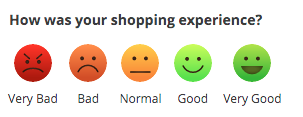What is Customer Experience?
Wiseback

Your customers may touch your brand at many points (physical store, product, service, website, call center, mobile application, online sales channel, etc.). All these contacts can take place before, during or after sales. Customer experience refers to the total value of your customer interaction at every touch point.
As a result of the emotional evaluations that occur at the contact points, a different value emerges for each experience, and a total value occurs as a result of all experiences. This total value constitutes the total customer experience. The effect of each experience that makes up the total customer experience may have different effects depending on the time.
 It is possible to effectively manage the customer experience by collecting and managing all the feedback from different channels such as website, mobile application, kiosk screens, sms, e-mail in a single point.
It is possible to effectively manage the customer experience by collecting and managing all the feedback from different channels such as website, mobile application, kiosk screens, sms, e-mail in a single point.
 As the answer to the question, you want a score between 0 and 10. Those who give you 9–10 are your supporters who recommend you, 7–8 are passive groups, and those who give 0–6 are the ones that disprove you who speak against you.
NPS = (Number of Promoters – Number of Detractors) / (Number of Respondents) x 100
As the answer to the question, you want a score between 0 and 10. Those who give you 9–10 are your supporters who recommend you, 7–8 are passive groups, and those who give 0–6 are the ones that disprove you who speak against you.
NPS = (Number of Promoters – Number of Detractors) / (Number of Respondents) x 100
 In the calculation, passives from these three groups are not taken into account. The other two groups are rated as (+) and (-), resulting in a score between -100 and +100%. This rate represents your business’s NPS®, the Net Referral Score. Most interesting thing in the calculation of NPS is that those who score 0 points and those who score 6 points have the same effect.
In the calculation, passives from these three groups are not taken into account. The other two groups are rated as (+) and (-), resulting in a score between -100 and +100%. This rate represents your business’s NPS®, the Net Referral Score. Most interesting thing in the calculation of NPS is that those who score 0 points and those who score 6 points have the same effect.
 In the question above, each option has a numerical value. According to the most widely used and accepted Likert scale, a score of 1-2-3-4-5 works. If we write these points out of 100, it will be 20-40-60-80-100.
In the question above, each option has a numerical value. According to the most widely used and accepted Likert scale, a score of 1-2-3-4-5 works. If we write these points out of 100, it will be 20-40-60-80-100.
What is Customer Experience Management?
Customer Experience Management is the whole work done to measure, evaluate and improve the total value given by your customers with scientific methods.Why is the Customer Experience important?
Every customer who steps into your store, every user who visits your website, every customer who contacts with your brand has a customer experience. As a result of the sum of all experiences of a customer with your brand, customer experience related to your brand is formed. With the result of this total experience, your customers decide whether to choose your brand. Businesses have to do business in a more competitive world day by day. While the costs of gaining new customers increased, keeping existing customers gained importance. Customer experience is considered a new battlefield in competition. When we look at the high level products and services offered to customers in every sector, almost similar products and services are offered today. However, the secret that some brands stand out in competition is hidden in their customer experience.How is the Customer Experience management done?
In the customer experience, you should first identify the points where the customers touch your brand. You should prepare customer journey maps starting at these points and provide feedback channels to your customers at each touch point. Don’t set up customer experience management like complaint management. Remember, your happy customers can also offer great suggestions and ideas for your business. The first step in customer experience management is to measure the experience. You can ask open or closed-ended questions according to the Likert Scale to find out what your customers are experiencing.In which sectors customer experience management should be done?
All businesses that offer products / services to the consumers must manage customer experience. Every business that provides services and products to consumers such as restaurants, coffees, retails, gyms, banks, insurance companies, event companies, automotive brands, supermarkets should manage customer experience.What is the Omni-channel customer experience management?
Omni-channel, a word created by using the word “omni” which means all in English and “channel”. Omni-channel, which is a marketing approach where all channels are managed centrally, is a method accepted for customer experience today. It is possible to effectively manage the customer experience by collecting and managing all the feedback from different channels such as website, mobile application, kiosk screens, sms, e-mail in a single point.
It is possible to effectively manage the customer experience by collecting and managing all the feedback from different channels such as website, mobile application, kiosk screens, sms, e-mail in a single point.
What is NPS®, Net Promoter Score?
Developed by Fred Reichheld, Bain & Company and Satmetrix Systems, NPS® is considered the most popular customer loyalty metric in recent years. NPS has been translated into Turkish as Net Referral Score. The system was first published by Reichheld in the article “One Number You Need To Grow” in Harvard Business Review in 2003. NPS divides your customers into 3 groups. The first group is promoters. This group consists of people who recommend you to your environment. The second group, passives, passive and ineffective, is considered to have no positive or negative effect on you. The third group, the detractors, is the group that speaks against you and makes you worse.How does NPS calculated?
You ask your customers a single key question for NPS measurement; Considering your complete experience with our company, how likely would you be to recommend us to a friend or colleague? As the answer to the question, you want a score between 0 and 10. Those who give you 9–10 are your supporters who recommend you, 7–8 are passive groups, and those who give 0–6 are the ones that disprove you who speak against you.
NPS = (Number of Promoters – Number of Detractors) / (Number of Respondents) x 100
As the answer to the question, you want a score between 0 and 10. Those who give you 9–10 are your supporters who recommend you, 7–8 are passive groups, and those who give 0–6 are the ones that disprove you who speak against you.
NPS = (Number of Promoters – Number of Detractors) / (Number of Respondents) x 100
 In the calculation, passives from these three groups are not taken into account. The other two groups are rated as (+) and (-), resulting in a score between -100 and +100%. This rate represents your business’s NPS®, the Net Referral Score. Most interesting thing in the calculation of NPS is that those who score 0 points and those who score 6 points have the same effect.
In the calculation, passives from these three groups are not taken into account. The other two groups are rated as (+) and (-), resulting in a score between -100 and +100%. This rate represents your business’s NPS®, the Net Referral Score. Most interesting thing in the calculation of NPS is that those who score 0 points and those who score 6 points have the same effect.
Why NPS is so important?
There is a strong correlation between customer satisfaction and NPS. With NPS®, you can easily measure and compare customer satisfaction. You can compare your NPS score periodically and evaluate the progress of your business. Today, NPS® is widely used in all sectors that touch the end consumer. The secret of sustainable success for a business is hidden in high NPS® score.What should be NPS?
The answer to this question will be different for each sector. First of all, you should look at the sector average of your business. As a general evaluation, it can be said that; You do not need to panic unless the NPS score drops to – (minus) but if you have an NPS score that is negative or tends to decrease, your business may be losing blood. It is very important to follow the NPS score periodically. Measure your NPS score instantly and compare it to monthly, weekly or daily periods.What is the Likert scale?
The Likert scale was developed by psychologist Rensist Likert in 1932. Likert Scale is a metholody used in many fields such as social sciences, political science, psychology, marketing and education. In the question above, each option has a numerical value. According to the most widely used and accepted Likert scale, a score of 1-2-3-4-5 works. If we write these points out of 100, it will be 20-40-60-80-100.
In the question above, each option has a numerical value. According to the most widely used and accepted Likert scale, a score of 1-2-3-4-5 works. If we write these points out of 100, it will be 20-40-60-80-100.